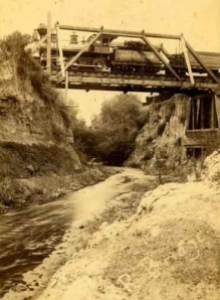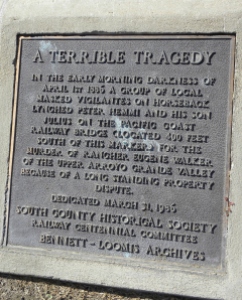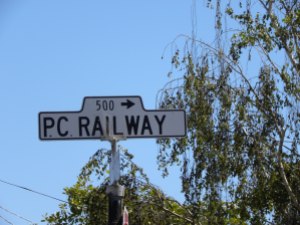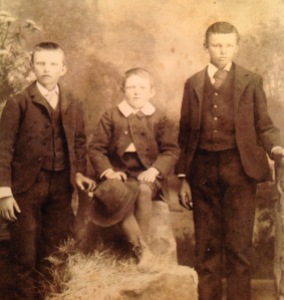
Santa Manuela School House – a one-room school house built in 1901 located in upper Arroyo Grande. – now fully-restored and on display in the Village of Arroyo Grande. Picture from http://www.arroyograndevillage.org/museums.shtml]
School Days
The boys would exit the school house through the windows, or so the story goes, of the very first school house built between San Luis Obispo and Santa Maria in 1867 by Francisco Branch, one of the first landowner in the Arroyo Grande, CA area.
Fred Grieb, father of Carl Grieb attended this school which was the first for the town site of Arroyo Grande. A three acre school site was deeded into the plan for the town of Arroyo Grande when the original 40,000 acres of the Santa Manuela-Arroyo Rancho land grant was divided.
Years later this school site was to be called, “un-safe” after a shoot-out occurred at a stable near the school where the stagecoaches changed horses. The school was then moved to an area which is now the corner of Traffic Way and Fair Oaks Avenue where the Ford dealership is today.
Carl Grieb started 1st grade at this school (where the Ford dealership is) until another elementary school was built off Orchard Street. Orchard school is now the 900 wing of Arroyo Grande High School. He attended Orchard school through 8th grade then went to the first High School, Crown Hill (built in 1906) which is now the current site of Paulding Middle school.

Paulding Middle School today – formerly Crown Hill High School where both Carl and Connie attended.
Connie went to Orchard for Jr. High for 6-8th grades then attended Crown Hill (now Paulding) for 9th grade. She returned as a teacher at Paulding Middle School and taught many students there from 1983 to 2010.
A Lynching

The railway bridge where two bodies hung from the trellis. Photo from South County Historical Society.
It was April Fool’s Day in 1886 and the school-kids were the first to report the event after a group of them ditched school and saw a site they would never forget . . . two bodies hanging from the Pacific Coast Railway bridge that crossed the Arroyo Grande Creek. Fred Grieb was one of these school kids.

The Hoosgow Jail in Arroyo Grande, CA.
In the wee hours of the morning a crowd of vigilantes broke into the Arroyo Grande jail where three people, a father and son plus a nephew, were being held for shooting and killing their neighbor due to a property squabble. The vigilantes hung the victims from the train trellis that crossed the Arroyo Grande creek just south of the old E.C. Loomis feed store off East Branch road in Arroyo Grande. The father and son were the two hanging; the nephew was seen running off with the rope still around his neck!

A marker describing the lynching can be found outside of the old E.C. Loomis Feed Store on East Branch Street in Arroyo Grande.
Pacific Coast Railway

The Pacific Coast Narrow-Gauge Railway came through Arroyo Grande through this route.
The sound of the train coming always broke the peaceful quiet of Arroyo Grande as it made its way from Santa Maria to San Luis Obispo, stopping in Arroyo Grande near the E.C. Loomis feed store. The train really opened up the movement of goods up and down the coast increasing the market for animal feed, produce, animal hides and dry goods.
The train came from Santa Maria through Arroyo Grande running parallel to E. Cherry Lane then turning North onto what is now Pacific Coast Railway road continuing on over the Arroyo Grande Creek, across to the E.C. Loomis Feed store and then ran East down behind the neighborhood around Paulding Middle School and North up Corbett Canyon to San Luis Obispo. The train bridge was moved sometime ago due to flooding.
With the arrival of the railroad in October 1881 came the idea of travel for the people of Arroyo Grande. The narrow-gage train made it possible to ride in comfort up to San Luis Obispo. One of the train cars even had red-velvet covered seats and wrought-iron adornments. The people of the town lived by the time-table of the little train until the development of the highway brought its use to a close in 1942.

Pacific Coast Railway Marker found outside the old E.C. Loomis Feed Store on East Branch Street.
Unless otherwise noted, all pictures taken by Sharon Jantzen


















